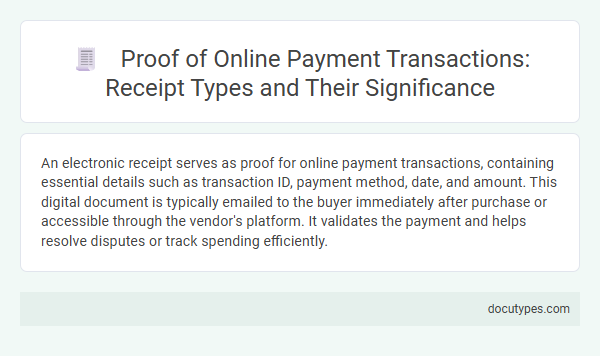An electronic receipt serves as proof for online payment transactions, containing essential details such as transaction ID, payment method, date, and amount. This digital document is typically emailed to the buyer immediately after purchase or accessible through the vendor's platform. It validates the payment and helps resolve disputes or track spending efficiently.
Introduction to Online Payment Transaction Receipts
Online payment transaction receipts serve as crucial documentation for purchases made through digital platforms. These receipts provide essential details confirming the completion of a transaction.
Typically, an online payment receipt includes the transaction ID, date and time of payment, payment method used, and the amount paid. This information helps both buyers and sellers verify and track transactions securely. Such receipts are often generated automatically by payment gateways or e-commerce platforms immediately after a transaction is processed.
Types of Digital Receipts in E-Commerce
What type of receipt serves as proof for online payment transactions? Digital receipts such as email confirmations and in-app purchase records commonly serve as valid proof for your online transactions. These receipts contain transaction details including payment method, amount, and date, which are essential for record-keeping and dispute resolution.
E-Mailed Receipts: Format and Importance
E-mailed receipts serve as essential proof for online payment transactions by providing a digital record of the purchase. These receipts include crucial transaction details formatted for clarity and verification purposes.
- Digital Format - E-mailed receipts are usually sent in HTML or PDF format, ensuring easy access and printing capabilities for the customer.
- Transaction Details - They contain specific information such as transaction ID, payment method, date, amount, and merchant details to verify the purchase.
- Legal and Accounting Importance - E-mailed receipts validate the transaction for both customer disputes and financial record-keeping, making them critical proof of payment.
In-App Receipts: Usage and Advantages
In-app receipts serve as proof for online payment transactions by providing detailed confirmation directly within the application where the purchase occurred. These receipts typically include transaction ID, payment method, date, and purchase details, ensuring accurate record-keeping. In-app receipts enhance user convenience and streamline expense tracking by eliminating the need to access external email or payment platforms.
Downloadable PDF Receipts: Security and Accessibility
Downloadable PDF receipts serve as reliable proof for online payment transactions, offering a secure and accessible record of the purchase. These receipts contain detailed transaction information, including payment date, amount, and merchant details.
PDF receipts enhance security by preventing unauthorized edits and ensuring data integrity through encryption features. They are easily stored, shared, and retrieved across devices, making them ideal for record-keeping and dispute resolution.
SMS and Push Notification Receipts
Receipts that serve as proof for online payment transactions include SMS and push notification receipts. SMS receipts provide a text message confirmation with transaction details immediately after payment. Push notification receipts appear on your device, offering instant verification and essential payment information.
Role of Receipts in Dispute Resolution
| Type of Receipt | Electronic Receipt |
|---|---|
| Description | An electronic receipt is a digital document confirming payment completion for an online transaction. It includes transaction details such as date, amount, payment method, merchant information, and a unique transaction ID. |
| Role in Dispute Resolution | Electronic receipts serve as primary evidence in online payment disputes by verifying the transaction validity, providing proof of payment, and enabling tracking of the transaction. They facilitate resolution by documenting the exact terms and confirming customer authorization. |
| Key Components Supporting Proof |
|
| Legal Significance | Courts and financial institutions recognize electronic receipts as valid proof of transaction in disputes related to chargebacks, fraud claims, or service disagreements. |
Compliance and Legal Significance of Digital Receipts
Digital receipts serve as essential proof for online payment transactions, ensuring compliance with financial regulations and facilitating accurate record-keeping. These electronic documents hold significant legal value in verifying payment authenticity and resolving disputes.
- Compliance with Financial Regulations - Digital receipts meet statutory requirements by documenting transaction details such as date, amount, and payment method.
- Legal Validity - Courts recognize digital receipts as valid evidence in legal proceedings related to payment verification and consumer protection.
- Audit and Record-Keeping - Maintaining digital receipts supports transparent financial audits and helps you track transaction histories efficiently.
Best Practices for Storing Proof of Payment
Receipts for online payment transactions serve as essential proof verifying that a payment has been successfully completed. These receipts typically include transaction details such as date, amount, payment method, and vendor information.
- Digital Payment Confirmation - This receipt often comes as an email or downloadable PDF from the payment gateway, confirming the transaction details and status.
- Bank or Credit Card Statement - Statements showing the transaction provide secondary verification and help reconcile payments with receipts from vendors.
- Secure Storage Practices - You should store digital receipts in encrypted folders or use dedicated expense management software to ensure easy access and protection from data loss.
Maintaining organized, secure records of your online payment receipts supports accurate bookkeeping and dispute resolution.
What Type of Receipt Serves as Proof for Online Payment Transactions? Infographic

